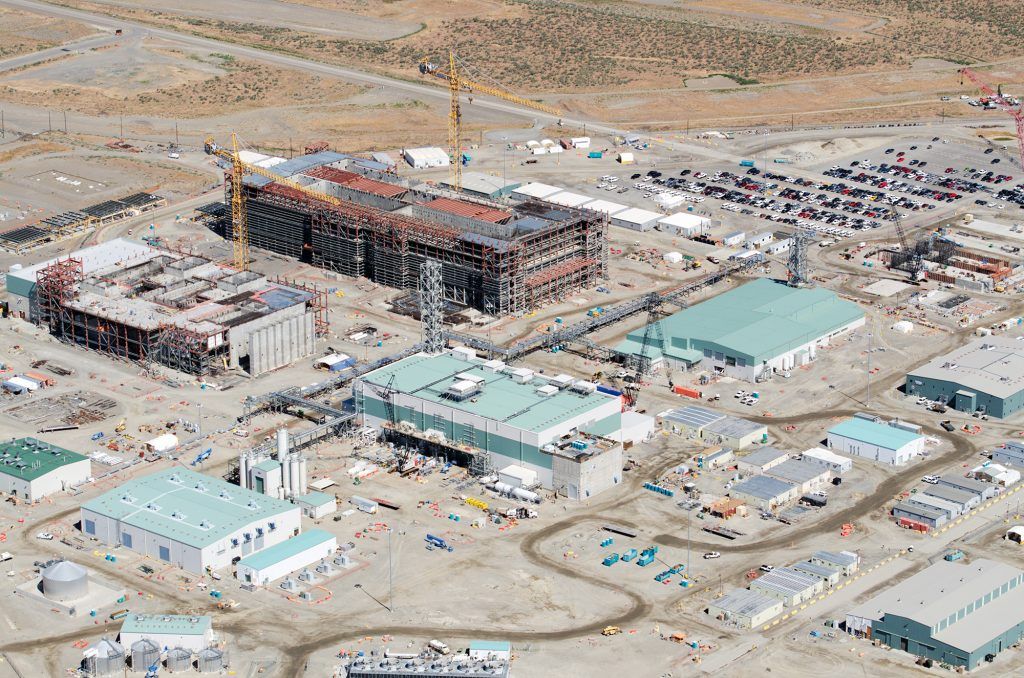“Incidental” nuclear waste: reconceiving a problem won’t make it go away
By Allison Macfarlane | January 31, 2019
 The Hanford Tank Waste Treatment and Immobilization Plant, also known as the Vit Plant, covers 65 acres with four nuclear facilities in southeastern Washington state. Credit: Bechtel National
The Hanford Tank Waste Treatment and Immobilization Plant, also known as the Vit Plant, covers 65 acres with four nuclear facilities in southeastern Washington state. Credit: Bechtel National
The Cold War left many legacies: thousands of nuclear weapons, a large nuclear weapons complex with its attendant personnel and infrastructure—and millions of gallons of dangerously radioactive waste stored in enormous buried tanks at the Hanford Site, Savannah River Site, and Idaho National Laboratory. The Energy Department recently proposed “re-interpreting” some of this high-level waste as low-level waste, if this material met certain criteria. The public comment period for the proposed change closed January 9, 2019, and commenters weighed in on both sides of the issue.
The states of Oregon and Washington strenuously objected to the Energy Department’s proposal to redefine some high-level wastes at, presumably, the Hanford Site in eastern Washington state. The Yakama Nation, which owns nearby lands, also objected, raising concerns about contamination of groundwater and the Columbia River.
In contrast, non-tribal local governments surrounding the Hanford Site, through their Energy Communities Alliance, supported the proposal, noting that taxpayers would save billions of dollars and shave years—even decades—off tank cleanup. Regardless of what the Energy Department decides, though, redefining some high-level waste won’t solve the biggest problems at Hanford, where the cleanup effort has been perpetually plagued with delays and cost overruns.
The bottom of the problem. This is not a new issue for the Energy Department. In 1999, the agency first proposed to leave a small portion of the waste in the tanks, redefining it as low-level waste, so that it could be disposed of in place—a shallow-land burial site, standard for low-level waste disposal. It turns out that removing every last drop of waste from these tanks is challenging and potentially costly.
The tank wastes were produced when irradiated uranium fuel from plutonium production reactors was chemically processed to extract plutonium for nuclear weapons. After the uranium and plutonium had been removed, the remaining mess contained the fission products, the rest of the actinides, and the radioactive fuel cladding in an acidic mix. To neutralize the acid so the tanks wouldn’t corrode, salts were added. Over time, tank wastes have separated into insoluble solids—the sludge, which sinks to the bottom—and the overlying salt waste, including a solid salt with a liquid layer on its surface. The plan is to remove the salt waste and most of the sludge, leaving a “heel” of sludge that is difficult to remove. It’s that heel that has, in essence, caused the current controversy.
To deal with the heel, the Energy Department proposed leaving it in place and filling the tank with grout, a cement-like material. That would be, in the department’s view, far easier than using difficult, costly, uncertain, and time-consuming methods to remove this layer of what was essentially high-level waste, based on its composition, radioactivity, and longevity. By assuming that the heel would mix with the grout, and then averaging the concentration of radionuclides in the filled tank, low-level waste requirements would be met. The trouble is, the heel doesn’t actually mix with the grout, so this calculation is misleading.
In response to the proposed redefining of the heel as “waste incidental to reprocessing,” the Natural Resources Defense Council, the Yakama Nation, the Shoshone-Bannock Tribes, and the Snake River Alliance sued. In 2003, a federal district court agreed with the environmental and tribal groups and ruled that the Energy Department had violated the Nuclear Waste Policy Act, which requires high-level waste from reprocessing to be buried in a deep geologic repository.
A two-state solution. In response to the court ruling, Republican Senator Lindsey Graham of South Carolina took up the Energy Department’s cause, and in 2004 attached a rider to the National Defense Authorization Act for Fiscal Year 2005 that allowed the department to redefine some high-level wastes as “waste incidental to reprocessing” in the states of South Carolina and Idaho. The bill also required the Energy Department to “consult” with the Nuclear Regulatory Commission when redefining waste. The Nuclear Regulatory Commission was given no legal authority over the Energy Department, but were it to detect noncompliance with regulations for disposal of low-level waste, the Commission would inform the Energy Department, the affected state, and relevant Congressional committees.
The Savannah River Site has made slow but steady progress in cleaning up its 51 tanks. Workers have closed eight tanks since 1997. They have immobilized high-level waste in more than 4,100 glass logs, each 10 feet long and 2 feet in diameter, at their Defense Waste Processing Facility. They have turned highly radioactive salt wastes into low-level-waste saltstone.
The Hanford Site, on the other hand, has made little progress on emptying its tanks. Hanford contains no less than 177 of these tanks, containing a total of 56 million gallons of liquid wastes. Up to 67 of the tanks may have leaks. A recent Government Accountability Office report notes that the Hanford site accounted for $141 billion (more than 52 percent) of the Energy Department’s fiscal year 2017 environmental liability.
The plans for Hanford are to clean out the tanks and solidify the low-level waste into glass logs. Cleanup has proceeded slowly since 1989, and none of the liquid waste has been processed into glass. In fact, the $17 billion vitrification facility has been under construction for 17 years.
The tank waste is treated differently at the two sites: At Savannah River, the low-level wastes are solidified in saltstone and disposed of at the site. At Hanford, Washington state has required the construction of the Waste Treatment and Immobilization Plant for the vitrification of the low-level wastes. Both South Carolina and Washington are allowed to regulate hazardous wastes under the Resource Conservation and Recovery Act, but they do so differently. South Carolina manages the low-level wastes as wastewater treatment under the Clean Water Act; Washington does not.
Technical roadblocks. At Savannah River, redefinition of the tank “heels” from high-level radioactive waste to “waste incidental to reprocessing” was not a magic bullet, and it likely won’t be for Hanford either. Multiple difficult technical issues dog the cleanup efforts. At Savannah River, cleanup has been delayed over how to remove cesium 137, a particularly harmful radionuclide, from the salt waste. Workers are only now testing a new method of cesium removal.
At least the Savannah River Site has built and operated a vitrification facility and a saltstone processing facility, made some progress on emptying its tanks, and treated 7 million gallons of tank waste. Hanford has accomplished none of these things yet. Hanford has seen a series of contractors come and go with little discernible progress. Simply redefining the waste will likely not make the problem go away. But it might make some folks at the Energy Department feel better.
Together, we make the world safer.
The Bulletin elevates expert voices above the noise. But as an independent nonprofit organization, our operations depend on the support of readers like you. Help us continue to deliver quality journalism that holds leaders accountable. Your support of our work at any level is important. In return, we promise our coverage will be understandable, influential, vigilant, solution-oriented, and fair-minded. Together we can make a difference.
Keywords: Hanford, Savannah River, tank waste, vitrification
Topics: Nuclear Risk, Nuclear Weapons, Opinion
















“They have immobilized high-level waste in more than 4,100 glass logs, each 10 feet long and 2 feet in diameter, at their Defense Waste Processing Facility.”
Over 20 years processing, on their third melter and not yet through 10% of their inventory of zoomies!! Ahh progress!